History of the syringe
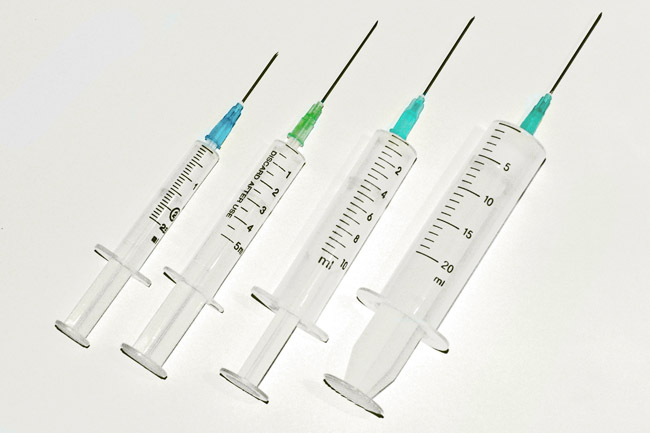
Syringe (German Spritze, from spritzen - to sprinkle) is the general name of instruments used in medicine, technology and cooking for the introduction and removal of liquids and gases using piston pressure.
Today, syringes are used for intramuscular, intravenous, subcutaneous and other injections, as well as for rinsing cavities, sucking out fluid and introducing nutrients.
Medical syringe
A syringe is a medical tool designed for injections, diagnostic punctures, suction of pathological contents from cavities.
Principle of operation
When raising the plunger of the syringe, if its needle is placed in a vessel with a liquid, a vacuum is created between it and the surface. There the liquid rushes from the vessel, because the atmospheric pressure acts on it.
Description

Usually the syringe is a hollow graduated cylinder with a cone on which the needle is inserted and an open end through which a piston with a rod is inserted into the cylinder. In the 1980s, single-use syringes (SHOP, the colloquial name: disposable syringes), almost entirely made of plastic, except for the needle, which is still made of stainless steel, were widely used. The syringe also has a large number of slang names on the slang of drug addicts. Also used are syringes (tubes) for single administration of medicines.
Basic rules of use
Since the syringe is in contact with blood during use, attention should be paid to the sterility of the syringe:
- Before using a disposable syringe, you must ensure the integrity of the package;
- Reusable syringes are boiled thoroughly before use.
For injection, the needle of the syringe is placed in the container with the drug, after which the necessary amount of the drug is drawn into the syringe cylinder by the movement of the piston. Before the injection, you should make sure that there are no air bubbles in the syringe. To do this, the syringe is guided with a needle upwards and the air from the syringe is expelled from the syringe with a light movement of the piston. The skin at the injection site must be rubbed with alcohol. Later, depending on the type of injection, the needle is injected into the patient's vein, under the skin or inside the skin, or inside the muscle, after which the drug moves from the syringe to the patient's body through the movement of the piston.
Types of disposable syringes
| Size | Needle |
|---|---|
| 1 ml (insulin / tuberculin) | 0.45 x 10 mm 26Gx2 / 5 0.40 x 10 mm 27Gx1 / 2 |
| 2 ml | 0.6 x 30 mm 23Gx1 1/4 |
| 3 ml | 0.6 x 30 mm 23Gx1 1/4 |
| 5 ml | 0,7 x 40 mm 22Gx1 1/2 |
| 10 ml | 0.8 x 40 mm 21Gx1 1/2 |
| 20 ml | 0.8 x 40 mm 21Gx1 1/2 |
| 50 ml | 1.2 x 40 mm 18Gx1 1/2 |
| 150 ml (syringe Janet) | 1,2 x 400 mm 80G x 1 1/20 |
History of creation
Despite the fact that intravenous injections have been carried out since the middle of the 17th century, the syringe, as we know it now, was invented only in 1853 by a veterinarian Charles Gabriel Pravaz and Alexander Wood independently From each other.
The first syringes were made from a rubber cylinder, inside of which was placed a well-fitted piston made of leather and asbestos with a metal pin protruding outward. At the other end of the cylinder, a hollow needle was reinforced. Since the cylinder was opaque, incisions for the dosage of the medicine were not made on it, but on the metal pin of the piston.
In 1949-1950 Arthur Smith received US patents for disposable syringes.
The first disposable syringes were mass-produced by Becton, Dickinson and Company in 1954. These syringes were made of glass.
In 1956, Colin Murdoch, a pharmacist from New Zealand, invented and patented a plastic disposable syringe.
Currently, many inventors are working on the idea of really disposable syringes - that is, those that would be physically impossible to use twice. This task is due to the fight against the spread of HIV and other infections. Some inventors have already achieved certain successes and even received patents on them, but there is really no reliable and economical solution to this problem. In a number of countries, needle exchange organizations are operating to exchange syringes to reduce the spread of HIV among drug users who often use the same syringe several times.
Despite the fact that the history of the creation of the syringe originates in the middle of the XIX century, mankind has long used a wide variety of methods for introducing and removing liquids from the body. So 2,500 years ago, the famous Hippocrates used a hollow tube to which the bladder of a pig was attached. In the XVII century, many scientists and doctors tried to carry out intravenous and subcutaneous injections, as well as transfusions using a bird feather.
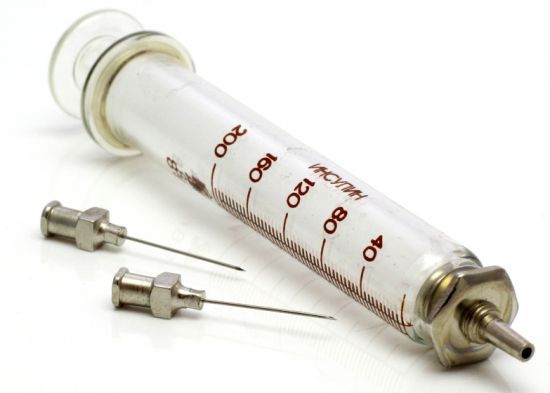
In general, the design of the press, that is, the cylinder, piston and needle, invented the French physicist and mathematician Pascal in 1648. It is called - the injector Pascal. But, unfortunately, the public of that time did not appreciate this development, and the invention was forgotten. Only in the middle of the XIX century, Dr. Alexander Wood, based on the injector, designed a syringe for the introduction of drugs under the skin. At the same time, surgeon Charles Gabriel Pravoz created a similar device for more use for operations.
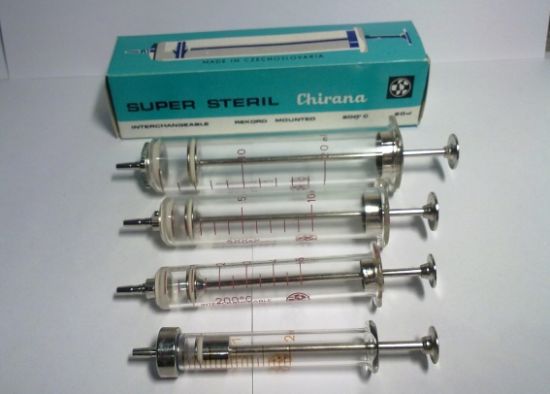
Glass syringes
The first syringes in history were made from leather and rubber, and notches for dosing were made on a metal piston. Glass reusable syringes produced by the company Luer appeared in 1894. At the heart of their design was the idea of the glassblower Fournier. Syringes were produced in a volume of 2 to 100 ml, had a conical connection of the needle with the syringe barrel and were made from chemically and thermally resistant glass, which allowed them to be successfully sterilized by different methods.

The history of disposable syringes began with the development of American Arthur Smith, who in 1949 patented the first glass disposable syringe. And just seven years later, the New Zealand pharmacist Colin Mardok invented a plastic disposable syringe. In subsequent years, he was actively engaged in the finalization and patenting of his invention, and by the 1970s Mardoc had a patent for a disposable plastic syringe in all countries of the world. And their industrial production has been established since 1961.
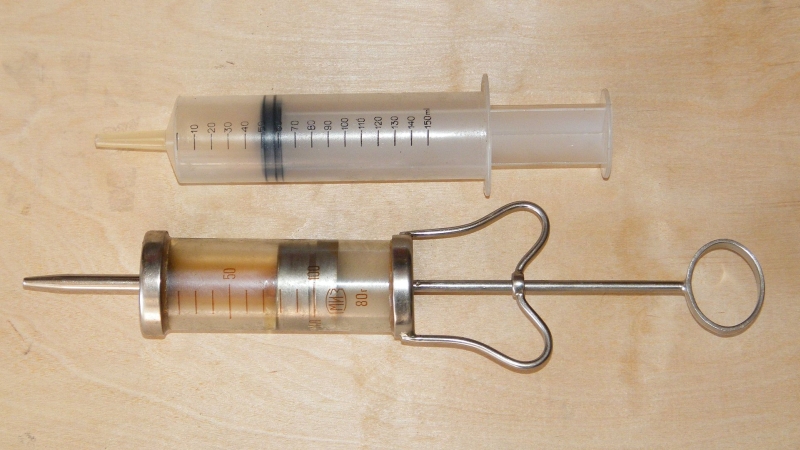
Syringe Janet
Currently, the development is carried out in two directions: firstly, the creation of syringes, which in principle can not be used twice, but so far there are no clear results, and, secondly, a reduction in the painfulness of the injections. For example, jagged needles with a smaller area of contact with the skin are created, devices that stick needles at high speed, a method of freezing needles before injection is also developed.
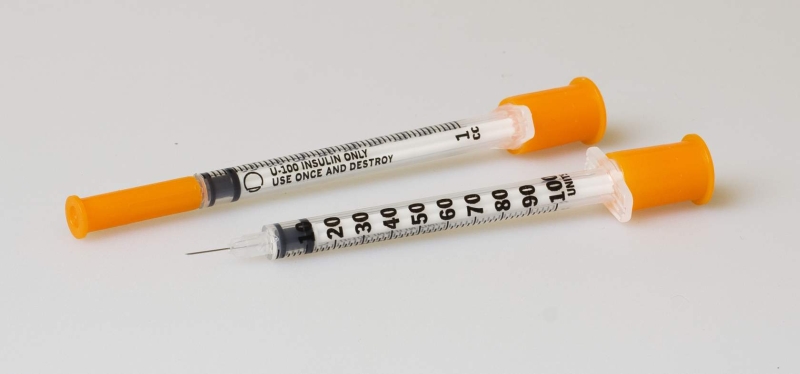
Insulin syringes
The last qualitative leap in the design is the replacement of two-component disposable syringes with three-component ones. All business in a small rubber band around the piston. It greatly reduced the pressing force, and accordingly. Painful sensations. The last picture is just 3-component. And the needles have long been so sharp that there is no problem in their further modernization - with the correct technique of injection it does not feel at all.


Comments
When commenting on, remember that the content and tone of your message can hurt the feelings of real people, show respect and tolerance to your interlocutors even if you do not share their opinion, your behavior in the conditions of freedom of expression and anonymity provided by the Internet, changes Not only virtual, but also the real world. All comments are hidden from the index, spam is controlled.